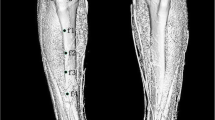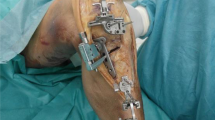Abstract
The KT-1000 is widely accepted as a tool for the instrumented measurement of the antero-posterior (AP) tibial translation. The aim of this study is to compare the data obtained with the KT-1000 in ACL deficient knees with the data obtained using a navigation system during “in vivo” ACL reconstruction procedures and to validate the accuracy of the KT-1000. An ACL reconstruction was performed using computer aided surgical navigation (Orthopilot, B-Braun, Aesculap, Tuttlingen, Germany) in 30 patients. AP laxity measurements were obtained for all patients using KT-1000 arthrometer (in a conscious state and under general anaesthesia) and during surgery using the navigation system, always at 30° of knee flexion. The mean AP translation was 14 ± 4 and 15.6 ± 3.8 mm using the KT-1000 in conscious and under general anaesthesia, respectively (P = 0.02) and 16.1 ± 3.7 mm using navigation. Measurements obtained with the KT-1000 under general anaesthesia were no different from those obtained “in vivo” with the navigation system (P = 0.37). In conclusion this study validates the accuracy of the KT-1000 to exactly calculate AP translation of the tibia, in comparison with the more accurate measurements obtained using a navigation system.


Similar content being viewed by others
References
Anderson KC, Buehler KC, Markel DC (2005) Computer-assisted navigation in total knee arthroplasty: comparison with conventional methods. J Arthroplasty 20(6 Suppl 3):132–138
Bach BR, Warron RF, Flynn WM et al (1990) Arthrometric evaluation of knees that have a torn anterior cruciate ligament. J Bone Joint Surg 72A:1299–1306
Bathis H, Perlick L, Tingart M et al (2004) Alignment in total knee arthroplasty a comparison of computer-assisted surgery with the conventional technique. J Bone Joint Surg Br 86:682–687
Blick SS, Daniel DM, Davis J et al (1989) Kinematics of the quadriceps stabilized anterior cruciate disrupted knee. Trans Orthop Res Soc 14:25
Cossey AJ, Spriggins AJ (2005) The use of computer-assisted surgical navigation to prevent malalignment in unicompartmental knee arthroplasty. J Arthroplasty 20:29–34
Daniel DM, Malcolm LL, Losse G et al (1985) Instrumented measurement of anterior laxity of the knee. J Bone Joint Surg 67A:720–725
Daniel DM, Stone ML, Sachs R et al (1985) Instrumented measurement of anterior knee laxity in patients with acute anterior cruciate ligament disruption. Am J Sports Med 13:401–407
Degenhart M (2004) Computer-navigated ACL reconstruction with the OrthoPilot. Surg Technol Int 12:245–251
Dessenne V, Lavallee S, Julliard R et al (1995) Computer-assisted knee anterior cruciate ligament reconstruction: first clinical tests. J Image Guid Surg 1:59–64
Ferretti A, Monaco E, Labianca L et al (2008) Double-bundle anterior cruciate ligament reconstruction: a computer-assisted orthopaedic surgery study. Am J Sports Med 36(4):760–766
Fleming B, Beynnon B, Erickson A et al (1989) An in vivo comparison of anterior joint laxity and strain in the anteromedial band of the anterior cruciate ligament. Trans Orthop Res Soc 14:326
Fleute M, Lavallee S, Julliard R (1999) Incorporating a statistically based shape model into a system for computer-assisted anterior cruciate ligament surgery. Med Image Anal 3:209–222
Fukubayashi T, Torzilli PA, Sherman MF et al (1982) An in vitro biomechanical evaluation anterior-posterior motion of the knee. J Bone Joint Surg 64A:258–264
Granberry WM, Noble PC, Woods GW et al (1989) The accuracy and reliability of instrumented measurement of knee laxity using the Genucom knee analysis system. Trans Orthop Res Soc 14:211
Haaker RG, Stockheim M, Kamp M et al (2005) Computer-assisted navigation increases precision of component placement in total knee arthroplasty. Clin Orthop Relat Res 433:152–159
Highgenboten CL, Jackson AW, Jansson KA et al (2004) KT-1000 arthrometer: conscious and unconscious test results using 15, 20, and 30 pounds of force. Am J Sports Med 20:450–454
Kim SJ, Macdonald M, Hernandez J et al (2005) Computer-assisted navigation in total knee arthroplasty: improved coronal alignment. J Arthroplasty 20(6 Suppl 3):123–131
King JB, Kumar SJ (1989) The Striker knee arthrometer in clinical practice. Am J Sports Med 17:649–650
Klos TV, Habets RJ, Banks AZ et al (1998) Computer assistance in arthroscopic anterior cruciate ligament reconstruction. Clin Orthop Relat Res 354:65–69
Kowalk DL, Wojtys EM, Disher J et al (1993) Quantitative analysis of the measuring capabilities of the KT-1000 knee ligament arthrometer. Am J Sports Med 21:744–747
Malcolm LL, Daniel DM, Stone ML et al (1985) The measurement of anterior knee laxity after ACL reconstructive surgery. Clin Orthop 196:35–41
Malcolm LL, Daniel DM, Stone ML (1980) Instrumented knee stability measurement technique knee ligament arthrometer, model KT-1000. MedMetric Corp., San Diego
Markolf KL, Kochan A, Amstutz HC (1984) Measurement of knee stiffness and laxity in patients with documented absence of the anterior cruciate ligament. J Bone Joint Surg 66A:242–253
Monaco E, Labianca L, Conteduca F et al (2007) Double bundle or single bundle plus extraarticular tenodesis in ACL reconstruction? A CAOS study. Knee Surg Sports Traumatol Arthrosc 15(10):1168–1174
Moody JE, Nikou C, Picard F et al (2002) Computer-integrated anterior cruciate ligament reconstruction system. J Bone Joint Surge Am 84(Suppl 2):99–101
Muller-Alsbach UW, Staubli AE (2004) Computer-aided ACL reconstruction. Injury 35(Suppl 1):S-A65-7
Pearle AD, Solomn DJ, Wanich T, Moreau-Gaudry A et al (2007) Reliability of navigated knee stability examination a cadaveric evaluation. Am J Sports Med 35:1315–1320
Picard F, DiGioia AM, Moody J et al (2001) Accuracy in tunnel placement for ACL reconstruction comparison of traditional arthroscopic and computer-assisted navigation techniques. Comput Aided Surg 6:279–289
Rangger C, Daniel DM, Stone ML (1993) Diagnosis of an ACL disruption with KT-1000 arthrometer measurements. Knee Surg Sports Traumatol Arthrosc 1:60–66
Sherman OH, Markolf KL, Ferkel RD (1987) Measurements of anterior laxity in normal and anterior cruciate absent knees with two instrumented test devices. Clin Orthop 215:156–161
Steiner ME, Brown C, Zarins B et al (1990) Measurement of anterior-posterior displacement of the knee: a comparison of the results with instrumented devices and with clinical examination. J Bone Joint Surg 72A:1307–1315
Torzilli PA, Greenberg RL, Hood RW et al (1984) Measurement of anterior-posterior motion of the knee in injured patients using a biomechanical stress machine. J Bone Joint Surg 66A:1438–1442
Wroble RR, Van Ginkel LA, Grood ES et al (1990) Repeatability of the KT-1000 arthrometer in a normal population. Am J Sports Med 18:396–399
Author information
Authors and Affiliations
Corresponding author
Rights and permissions
About this article
Cite this article
Monaco, E., Labianca, L., Maestri, B. et al. Instrumented measurements of knee laxity: KT-1000 versus navigation. Knee Surg Sports Traumatol Arthrosc 17, 617–621 (2009). https://doi.org/10.1007/s00167-009-0724-1
Received:
Accepted:
Published:
Issue Date:
DOI: https://doi.org/10.1007/s00167-009-0724-1




